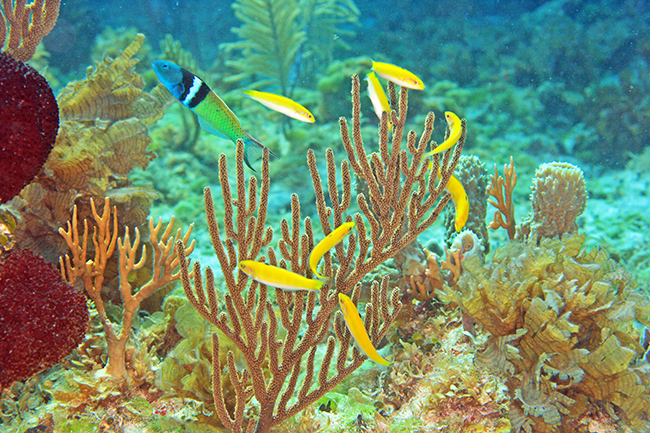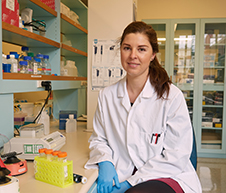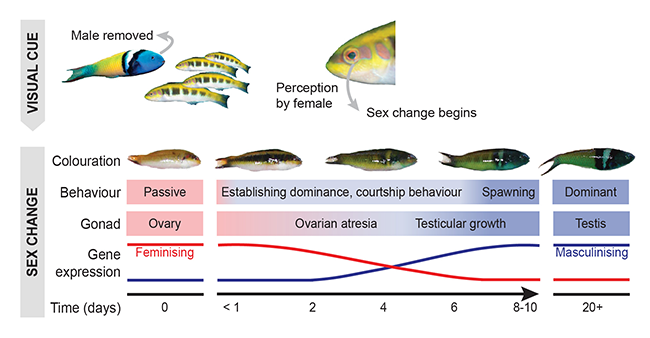Thursday 11 July 2019 2:11pm

A distinctive male (top left) defends a group of females (yellow), one of which will eventually change sex to replace him. Photo: Kevin Bryant.
A University of Otago-led study is heralding advances in our understanding of one of the most startling transformations in the natural world – the complete reversal of sex that occurs in about 500 species of fish.

Dr Erica Todd.
Co-lead author Dr Erica Todd, of the Department of Anatomy, says many of us take it for granted that our biological sex is fixed at birth. However, many fish, such as the clownfish from Finding Nemo, the kobudai from Blue Planet II, and the Caribbean bluehead wrasse, routinely change their sex in adulthood as a natural part of their lifecycle.
“Most bluehead wrasses begin life as females, but can change sex sometime later to become males – a process that takes just 10–21 days from start to finish.
“When a dominant male is lost from a social group, the largest female transforms into a fertile male in 10 days flat. Females begin this transformation within minutes, first changing colour and displaying male-like behaviours. Her ovaries then start to regress and fully functional testes grow in their place.
“How this stunning transformation works at a genetic level has long been an enigma,” Dr Todd says.
Using the latest genetic approaches, high-throughput RNA-sequencing and epigenetic analyses, the researchers discovered when and how specific genes are turned off and on in the brain and gonad so that sex change can occur.
“Our study reveals that sex change involves a complete genetic rewiring of the gonad. We find that genes needed to maintain the ovary are first turned off, and then a new genetic pathway is steadily turned on to promote testis formation.”

This chain reaction begins when a gene called aromatase, which is responsible for making the female hormone estrogen, is turned off. What triggers aromatase to turn off is unknown, but the stress of social change resulting from the loss of the existing dominant male may be an important signal in turning off the genetic pathway that maintains the ovary.
Co-lead author PhD candidate Oscar Ortega-Recalde, also of the Department of Anatomy, says the amazing transformation also appears possible through changes in cellular “memory”.
“In fish and other vertebrates, including humans, cells use chemical markers on DNA that control gene expression and remember their specific function in the body. Our study is important because it shows that sex change involves profound changes in these chemical marks, for example at the aromatase gene, thus reprogramming cell memory in the gonad towards a male fate,” he says.
As many genes important for sexual development in fish are also important in other animals, the team’s discovery has practical applications for humans.
“Understanding how fish can change sex may tell us more about how complex networks of genes interact to determine and maintain sex, not only in fish but in vertebrate animals generally,” Dr Todd says.
The “remarkable” speed at which a bluehead wrasse’s ovaries can be transformed into new testes also opens up the possibility of applications in tissue and organ engineering, with potential benefits to medical science.
Furthermore, understanding sex change at a genetic level may also have benefits for aquaculture industries, as about 500 fish species, including many of commercial value such as New Zealand’s iconic blue cod, can also change sex.
This work is part of a highly-collaborative project involving Professor Neil Gemmell, Dr Tim Hore and others of Otago’s Department of Anatomy, colleagues in Otago’s Department of Biochemistry, and researchers from North Carolina State University, USA.
The work was funded by the Royal Society of New Zealand Marsden Fund, the Rutherford Foundation, the University of Otago, and the National Science Foundation (USA).
Video
A female becomes a male: a transitioning bluehead wrasse (darker colouration) establishes dominance and begins courting females (yellow colouration). Video: John Godwin and William Tyler.
A distinctive male bluehead wrasse patrols a spawning territory and courts females (yellow), one of which will eventually change sex to replace him. Video: John Godwin and William Tyler.
Publication details
Stress, novel sex genes, and epigenetic reprogramming orchestrate socially controlled sex change
Erica V. Todd, Oscar Ortega-Recalde, Hui Liu, Melissa S. Lamm, Kim M. Rutherford, Hugh Cross, Michael A. Black, Olga Kardailsky, Jennifer A. Marshall Graves, Timothy A. Hore, John R. Godwin, Neil J. Gemmell.
Science Advances
For more information, contact:
Dr Erica Todd
Department of Anatomy
University of Otago
Email erica.v.todd@otago.ac.nz
Electronic addresses (including email accounts, instant messaging services, or telephone accounts) published on this page are for the sole purpose of contact with the individuals concerned, in their capacity as officers, employees or students of the University of Otago, or their respective organisation. Publication of any such electronic address is not to be taken as consent to receive unsolicited commercial electronic messages by the address holder.
